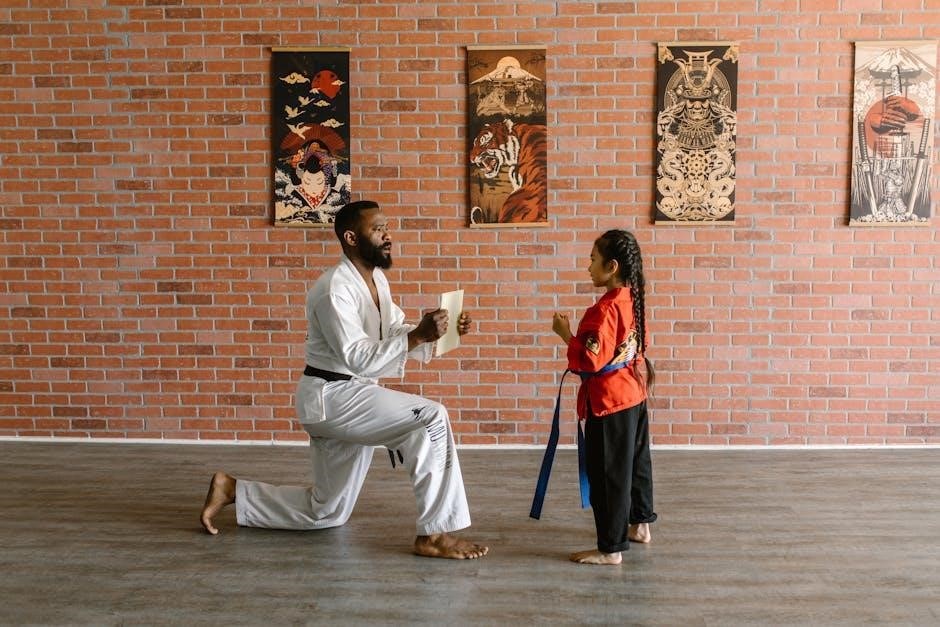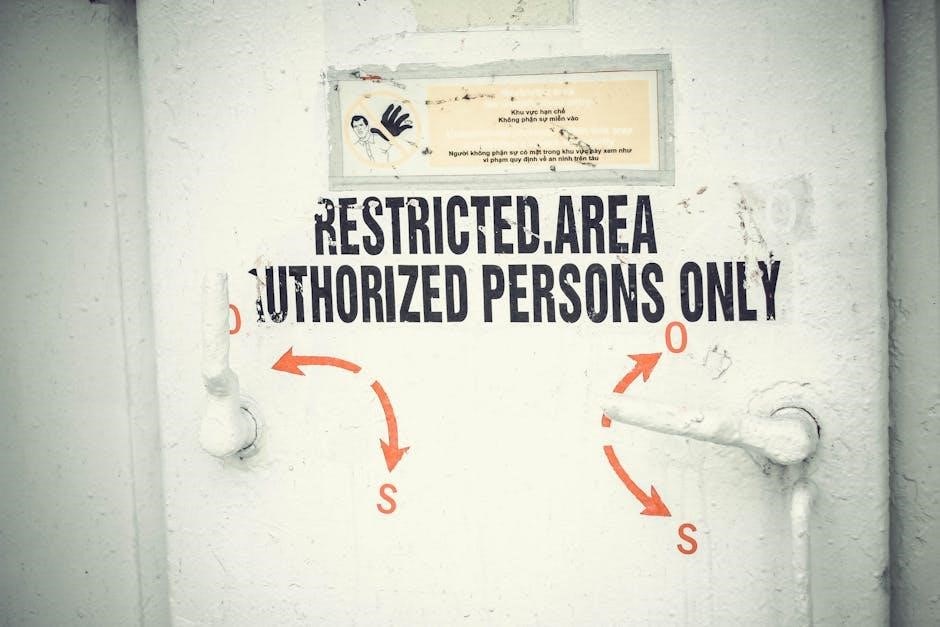Crossword clues are hints designed to guide solvers in finding hidden words within a grid. They can be straightforward or complex, requiring clever interpretation and vocabulary skills. The clue “Instruct to do something” is a classic example, often leading to answers like ENJOIN or TEACH, which fit seamlessly into the puzzle’s structure. Understanding the art of clue-crafting is essential for mastering crosswords, as it combines logic, wordplay, and linguistic nuances. This introduction sets the stage for exploring the intricacies of crossword solving, starting with the basics and moving to advanced techniques;
1.1. Understanding the Basics of Crossword Puzzles
Crossword puzzles are grids filled with black squares and numbered squares where words are placed. Each number corresponds to a clue, either “Across” (horizontal) or “Down” (vertical). The goal is to fill in the grid using the clues, which often involve wordplay, synonyms, or definitions. The clue “Instruct to do something” is a common type, requiring solvers to think of verbs like ENJOIN or TEACH. Crosswords rely on vocabulary, pattern recognition, and logical thinking. They are popular for their mental stimulation and the satisfaction of filling in the final answer.
1.2. The Role of Clues in Crossword Solving
Clues are the backbone of crossword puzzles, providing essential hints to help solvers determine the correct words. They can be straightforward definitions or cleverly crafted riddles. For the clue “Instruct to do something,” solvers must decipher its meaning, often leading to answers like ENJOIN or TEACH. Clues guide the solver by indicating word lengths, starting letters, or synonym possibilities. They also challenge the solver’s vocabulary and reasoning skills, making crosswords both entertaining and intellectually stimulating. Effective clues strike a balance between difficulty and fairness, ensuring the puzzle remains solvable and enjoyable.
1.3. Strategies for Decoding Crossword Clues
Decoding crossword clues requires a mix of vocabulary, logic, and pattern recognition. Start by breaking down the clue into its core components, identifying key words like “instruct” or “do something.” Consider synonyms and related phrases, such as “ENJOIN” or “TEACH,” which often fit the context. Pay attention to word lengths and letter patterns, as these can narrow down possibilities. Additionally, using online crossword solvers or dictionaries can provide insights, while practicing regularly enhances your ability to recognize common clue structures and themes. These strategies combine to make crossword solving more efficient and enjoyable.

The Specific Clue: “Instruct to Do Something”
The crossword clue “Instruct to do something” appeared in the Missing Letter Crossword on November 27, 2023, with ENJOIN as the six-letter solution meaning to command someone to act.
2.1. Analyzing the Clue Structure
The clue “Instruct to do something” is structured to guide solvers to a specific word, often six letters long. By breaking it down, “instruct” implies authority, while “to do something” suggests action. This dual focus narrows the possibilities, directing solvers to words like ENJOIN or TEACH. The structure is clear yet challenging, requiring both vocabulary knowledge and an understanding of word meanings. This approach is common in crosswords, where precision in phrasing leads to the correct answer.
2.2. Identifying the Key Words and Phrases
The clue “Instruct to do something” highlights the key words instruct and do something. Instruct implies teaching, guiding, or commanding, while do something suggests an action. Together, they form a clear directive, pointing to verbs like ENJOIN, TEACH, or COMMAND. These words align with the clue’s intent, making them strong candidates. Identifying such key elements helps narrow down potential answers, streamlining the solving process. This step is crucial for effective crossword puzzle-solving, ensuring accuracy and efficiency.
2.3. Understanding the Context of the Clue
The clue “Instruct to do something” implies guiding or directing an action. Synonyms like “teach” or “command” fit, with “enjoin” being a strong candidate. Contextually, it suggests authority or formality. Crossword answers often align with common verbs, making “enjoin” a likely fit. Surrounding words in the grid can offer letter hints, aiding in precise answer identification. This contextual understanding enhances solving efficiency and accuracy, crucial for crossword enthusiasts aiming to conquer puzzles effectively.

Possible Answers to the Clue
The primary answer is ENJOIN, a formal verb meaning to instruct. Other possible solutions include TEACH, COMMAND, and DIRECT. Each answer’s relevance depends on context.
3.1. ENJOIN as the Primary Answer
ENJOIN is the most common and fitting answer for the clue “Instruct to do something.” It is a verb that means to formally instruct or command someone to perform an action. For example, “She enjoined him to complete the task immediately.” This six-letter word is frequently used in crossword puzzles due to its precise meaning and versatility. ENJOIN is often highlighted as the primary solution in many crossword databases, making it a reliable choice for solvers. Its formal tone aligns well with the authoritative nature of the clue, ensuring accuracy and relevance in the puzzle context.
3.2. Other Possible Solutions: TEACH, COMMAND, DIRECT
Beyond ENJOIN, other verbs like TEACH, COMMAND, and DIRECT can also fit the clue “Instruct to do something.” TEACH implies imparting knowledge, while COMMAND suggests giving an order, and DIRECT involves guiding actions. Each has a slightly different nuance and usage. Considering the crossword’s theme and word length is crucial. For example, TEACH (5 letters) and DIRECT (6 letters) offer flexibility, while COMMAND (7 letters) might be too long. These alternatives provide solvers with options depending on the puzzle’s context and design.
3.3. Evaluating the Relevance of Each Answer
Evaluating the relevance of each answer is crucial for accurate crossword solving. ENJOIN, TEACH, COMMAND, and DIRECT each fit the clue “Instruct to do something,” but their suitability depends on the crossword’s context. ENJOIN is often the primary choice due to its formal tone, while TEACH emphasizes learning. COMMAND and DIRECT are more authoritative and action-oriented. Considering word length, letter patterns, and the puzzle’s theme helps narrow down the most appropriate answer. Crossword solvers must also ensure the chosen word aligns with surrounding clues and grid constraints for a seamless solution.

How to Solve the Clue
To solve the clue “Instruct to do something,” start by analyzing its structure and identifying key words like “instruct” and “do.” Consider word lengths and patterns, and use crossword tools or dictionaries to refine potential answers. Cross-referencing with other clues in the puzzle can also help narrow down the correct solution efficiently.
4.1. Breaking Down the Clue into Manageable Parts
Start by dissecting the clue “Instruct to do something” into smaller components. Identify key words like “instruct” and “do,” which suggest action and direction. Consider synonyms for “instruct,” such as “enjoin,” “command,” or “urge.” Analyze the word length and letter patterns to narrow down potential answers. Cross-referencing with other clues in the puzzle can further refine your search. This methodical approach helps in efficiently pinpointing the correct solution.
4.2. Using Word Length and Letter Patterns
Identifying word length is crucial for narrowing down potential answers. For “Instruct to do something,” the answer “ENJOIN” is six letters long, matching common crossword puzzle standards. Look for letter patterns, such as starting with “E” or ending with “N,” which can help eliminate unlikely options. Crossword tools often allow filtering by word length and patterns, making it easier to pinpoint the correct answer. This strategy, combined with clue analysis, significantly reduces the search space and leads to efficient solving.
4.3. Leveraging Crossword Solver Tools and Resources
Utilizing crossword solver tools can significantly simplify the solving process; These tools analyze clues, word lengths, and letter patterns to suggest potential answers. For “Instruct to do something,” tools like crossword-solver.com or Crossword Solver apps can quickly identify “ENJOIN” as the most likely solution. They also provide definitions and usage examples, ensuring accuracy. Additionally, these resources often include databases of past puzzles, allowing solvers to cross-reference answers and avoid common mistakes. Leveraging such tools enhances efficiency and reduces frustration, making crossword solving more enjoyable and rewarding for enthusiasts of all skill levels.

Tips for Crossword Enthusiasts
Expand your vocabulary, recognize common clue patterns, and stay focused. Practice regularly to improve word recognition and synonyms knowledge, essential for solving clues like “instruct to do something.”
5.1. Building a Strong Vocabulary for Crossword Success
A robust vocabulary is key to mastering crosswords. Regularly reading books, newspapers, and solving puzzles expands your word knowledge. Learn synonyms and antonyms, especially for common clue words like “instruct,” which can mean ENJOIN, TEACH, or COMMAND. Flashcards and word lists are great tools for memorization. For the clue “instruct to do something,” understanding synonyms like DIRECT or URGE can help. Explore word origins and meanings to decode clues more efficiently. Strengthening your vocabulary will enhance your problem-solving skills and make crosswords more enjoyable and rewarding over time.
5.2. Recognizing Common Crossword Themes and Patterns
Recognizing common crossword themes and patterns is crucial for solving clues efficiently. Many puzzles follow specific structures, such as anagrams, word chains, or thematic associations. For the clue “instruct to do something,” patterns like verb-based answers (e.g., ENJOIN) or synonyms for “command” are common; Pay attention to recurring themes, such as word lengths or letter combinations, which can help narrow down possibilities. Regularly solving crosswords trains your mind to identify these patterns, making you more adept at decoding clues quickly and accurately. This skill enhances your overall crossword-solving experience and speed.
5.3. Managing Time and Staying Focused During Solving
Managing time and maintaining focus are essential skills for crossword enthusiasts. Allocating specific time slots for solving helps prevent distractions and enhances concentration. Start with easier clues to build momentum, then tackle more challenging ones like “instruct to do something.” Using techniques such as breaking clues into parts or prioritizing shorter answers can optimize your workflow. Regular practice improves both speed and accuracy, allowing you to enjoy the puzzle without feeling rushed. Staying focused ensures a more enjoyable and productive crossword-solving experience.

The Importance of Word Meanings
Understanding word meanings is crucial for solving crossword clues like “instruct to do something.” Knowing synonyms like ENJOIN or TEACH helps identify the correct answer, ensuring accuracy and efficiency in solving puzzles.
6.1. Understanding Synonyms and Antonyms
Understanding synonyms and antonyms is vital for decoding crossword clues like “instruct to do something.” Synonyms such as ENJOIN, TEACH, COMMAND, and DIRECT provide multiple pathways to the solution. Antonyms, while less relevant here, can sometimes offer contrasting insights. Recognizing these word relationships enhances vocabulary and improves solving efficiency. For instance, ENJOIN implies a formal instruction, while TEACH suggests guiding someone to learn. Grasping these nuances aids in selecting the most appropriate answer, ensuring accuracy and confidence in crossword puzzle-solving endeavors.
6.2. Exploring the Nuances of Word Usage
Exploring word nuances is crucial for solving clues like “instruct to do something.” ENJOIN, the primary answer, connotes a formal or legal instruction, while TEACH implies guidance or education. COMMAND and DIRECT suggest authority, differing slightly in tone. Understanding these distinctions helps in selecting the most fitting word for the crossword context. For example, ENJOIN is often used in legal settings, whereas TEACH aligns with educational scenarios. Recognizing these subtleties enhances problem-solving and ensures accuracy in crossword puzzle answers.
6.3. Avoiding Common Misinterpretations
Avoiding common misinterpretations is vital when solving crossword clues like “instruct to do something.” Many solvers mistakenly assume all synonyms for “instruct” are interchangeable. For example, while ENJOIN fits perfectly, words like TEACH or COMMAND may not align with the clue’s specific context or word length. Misinterpreting the nuance of “instruct” can lead to incorrect answers. Paying attention to word connotations and ensuring the answer fits grammatically within the sentence structure helps avoid errors. Double-checking definitions and considering the crossword’s theme can also prevent misinterpretations and ensure accuracy.
Crossword Puzzle Resources
Utilize online tools like Crossword Solver and NYTimes Crossword for quick solutions. Download apps such as Crossword Puzzle Free or Word Crossy for on-the-go solving. Explore books like “The Crossword Solver’s Handbook” for tips and strategies to enhance your skills.
7.1. Recommended Websites for Crossword Solutions
For solving crossword clues like “Instruct to do something,” websites such as NYTimes Crossword, Crossword Solver, and USA Today Crossword are highly recommended. These platforms offer searchable databases, examples, and solutions for various puzzles. NYTimes Crossword provides daily puzzles and archives, while Crossword Solver allows filtering by clue length and difficulty. USA Today Crossword is known for its user-friendly interface and quick solutions. These resources are invaluable for both beginners and experienced solvers, helping them crack even the toughest clues efficiently.
7.2. Apps and Tools for Crossword Enthusiasts
Several apps and tools are available to assist crossword enthusiasts in solving clues like “Instruct to do something.” Word Cross is a popular app that combines word scrambles with crossword mechanics. Crossword Puzzle by PuzzleBuzz offers daily puzzles and hints. Additionally, Crossword Solver allows users to input clues and find solutions instantly. These tools provide features like word lists, anagram solvers, and pattern recognition, making them indispensable for both casual players and serious crossword aficionados aiming to solve puzzles efficiently and accurately.
7.3. Books and Guides for Improving Crossword Skills
Enhancing crossword skills requires dedication and the right resources. Books like The Crossword Solver’s Handbook provide comprehensive guides on decoding clues, including those like “Instruct to do something.” Crossword Puzzles for Dummies offers tips for beginners, while Mastering Crosswords: The Expert’s Guide caters to advanced solvers. These books cover strategies, common themes, and wordplay techniques. They also include practice puzzles and exercises to help improve vocabulary and pattern recognition, making them invaluable for anyone aiming to become a crossword expert and solve challenging clues with confidence and precision.

Solving Crosswords as a Hobby
Solving crosswords as a hobby offers mental stimulation, relaxation, and a sense of achievement. It enhances vocabulary, memory, and cognitive flexibility, making it a rewarding pastime for many enthusiasts who enjoy the challenge of clues like “Instruct to do something” leading to answers like ENJOIN or TEACH. Regular practice fosters a deeper understanding of wordplay and patterns, turning crosswords into a lifelong passion and intellectual pursuit that combines fun with mental exercise and personal growth.
8.1. The Benefits of Regular Crossword Solving
Engaging in crossword puzzles regularly offers numerous cognitive benefits. It enhances memory retention, boosts vocabulary, and sharpens critical thinking skills. Solving clues like “Instruct to do something” stimulates the brain, fostering mental agility and focus. Crosswords also promote relaxation and provide a sense of accomplishment with each solved clue. Over time, frequent solvers develop a keen understanding of wordplay and patterns, making the hobby both intellectually rewarding and enjoyable. This mental exercise contributes to overall brain health and can be a fulfilling leisure activity for people of all ages.
8.2. Engaging with Crossword Communities
Engaging with crossword communities enhances the solving experience by connecting enthusiasts worldwide. These groups share strategies, discuss challenging clues, and celebrate successes. For clues like “Instruct to do something,” community insights can reveal answers like ENJOIN or TEACH. Online forums, social media groups, and local clubs foster camaraderie and learning. Collaborative problem-solving and friendly competitions motivate solvers to improve their skills. Being part of a crossword community creates a sense of belonging and amplifies the joy of conquering difficult puzzles. It also provides a platform to learn from others and share knowledge, enriching the hobby for all participants.
8.3. Setting Goals and Tracking Progress
Setting goals helps crossword enthusiasts stay motivated and track their improvement. Start with achievable targets, like solving a certain number of clues daily or mastering specific puzzle types. Tracking progress through journals or apps can reveal strengths and areas for growth. For example, focusing on clues like “Instruct to do something” can enhance vocabulary and pattern recognition. Celebrate milestones, such as correctly answering complex clues like ENJOIN, to stay inspired. Regular reflection on progress fosters consistency and enjoyment, making crossword solving a rewarding and ongoing journey of learning and skill development.

Advanced Crossword Techniques
Advanced solvers use techniques like recognizing anagrams and hidden meanings. For “Instruct to do something,” understanding wordplay and verb nuances can quickly lead to answers like ENJOIN, enhancing solving efficiency.
9.1. Mastering Anagrams and Wordplay
Anagrams are a key part of advanced crossword solving, requiring solvers to rearrange letters creatively. For “Instruct to do something,” recognizing anagrams like ENJOIN or TEACH can unlock the answer. Wordplay, such as puns or double meanings, is also common, where clues might hint at multiple interpretations. For example, “enjoin” can mean both “to instruct” and “to join,” adding layers of complexity. Mastery of these techniques involves practicing pattern recognition and staying attuned to linguistic tricks, making solving more efficient and enjoyable for experienced puzzlers.
9.2. Decoding Cryptic Clues
Cryptic clues rely heavily on wordplay, puns, and indirect hints. For “Instruct to do something,” solvers must decipher layers of meaning. The answer ENJOIN, for instance, can be split into “enjoin,” meaning to instruct, and “join,” adding a dual interpretation. Recognizing such patterns is crucial. Cryptic clues often involve anagrams, homophones, or double meanings, requiring solvers to think creatively. Practice and experience help in identifying these subtle hints, making the solving process both challenging and rewarding for crossword enthusiasts.
9;3. Utilizing Crossword Grid Patterns
Crossword grids follow specific patterns that solvers can exploit. Symmetrical designs and intersecting words provide structural clues. For “Instruct to do something,” identifying word lengths and letter overlaps is key. Shorter answers often appear in corners, while longer ones span centrally. Patterns like alternating black squares and word directions (across or down) help narrow possibilities. Recognizing common letter placements and grid flow enhances solving efficiency, making grid analysis a vital skill for tackling clues like ENJOIN effectively.

Common Mistakes to Avoid
Common mistakes include overlooking obvious clues like ENJOIN and misinterpreting word meanings. Forgetting to double-check answers can lead to errors, so careful review is essential.
10.1. Overlooking Obvious Clues
Overlooking obvious clues is a common mistake in crossword solving. For instance, the clue “Instruct to do something” often points to the straightforward answer ENJOIN, yet solvers may overcomplicate it. This happens when one focuses too much on complex interpretations or misses the simplicity of the clue. Additionally, familiarity with the clue can lead to complacency, causing solvers to skip proper analysis. To avoid this, it’s essential to approach each clue with a fresh perspective and verify answers against the grid. Taking breaks and revisiting clues can also help prevent this error, ensuring a more accurate solve.
10.2. Misinterpreting Word Meanings
Misinterpreting word meanings is another common pitfall in crossword solving. For example, the clue “Instruct to do something” might lead solvers to confuse the word “enjoin” with “teach” or “direct.” While all these words imply giving instructions, their connotations and usage differ. ENJOIN specifically means to order or command formally, making it the most precise fit. Misinterpretation often arises from overlooking subtle differences in word meanings or assuming a clue refers to a more common synonym. This highlights the importance of understanding context and nuance in crossword clues to avoid errors.
10.3. Neglecting to Double-Check Answers
Neglecting to double-check answers is a common mistake that can lead to incorrect solutions. For instance, assuming “TEACH” fits the clue “Instruct to do something” without verifying its length or context can result in errors. Crossword puzzles often require precision, and overlooking small details can disrupt the entire grid. Taking a moment to review each entry ensures accuracy and prevents costly mistakes. Double-checking also helps confirm that the answer aligns with the clue’s intended meaning, such as distinguishing between “ENJOIN” and “TEACH.” This step is crucial for avoiding frustration and ensuring a smooth solving experience.

Final Thoughts and Next Steps
Mastering crossword clues like “Instruct to do something” enhances vocabulary and critical thinking. Embrace the challenge, explore resources, and enjoy the journey of learning and growth.
Stay curious, practice regularly, and engage with crossword communities to deepen your skills. Remember, every solved clue brings joy and intellectual fulfillment.
11.1. Encouragement for Continuing Crossword Solving
Embrace the journey of crossword solving with enthusiasm and determination. Each clue, like “Instruct to do something,” offers a chance to grow your vocabulary and sharpen your mind. Solving crosswords regularly fosters mental agility and patience, while the satisfaction of uncovering answers like ENJOIN or TEACH builds confidence. Celebrate small victories and view challenges as opportunities to learn. Stay curious, explore new clues, and enjoy the rewarding process of mastering this intellectual hobby.
11.2. Suggestions for Further Learning
To deepen your crossword-solving skills, explore resources like crossword solver tools and websites such as the-crossword-solver.com. Expand your vocabulary by reading books and guides focused on crossword techniques. Practice regularly with daily puzzles from sources like the NY Times or Telegraph. Engage with crossword communities to learn from experienced solvers and gain insights into common themes and patterns. Consider using apps like Word Cross for creative challenges and to sharpen your wordplay abilities. Consistency and curiosity are key to mastering this rewarding hobby.
11.3. Embracing the Joy of Crossword Puzzles
Embrace the joy of crossword puzzles by viewing them as a fun, intellectual challenge. Solving crosswords fosters a sense of accomplishment and mental relaxation. The satisfaction of uncovering answers like ENJOIN for “Instruct to do something” is rewarding. Engage in puzzles as a hobby to enhance vocabulary, improve cognitive skills, and unwind. Share the experience with others through crossword communities, making it a social and enjoyable activity. Celebrate each solved clue as a step toward mastering this timeless, brain-stimulating pastime that combines learning with leisure.
